
The Milan Metro is the rapid transit system serving Milan, Italy, operated by Azienda Trasporti Milanesi. The network consists of 5 lines with a total network length of 104.1 kilometres (64.7 mi), and a total of 113 stations, mostly underground. It has a daily ridership of about 1.4 million on weekdays. The Milan Metro is the largest system in Italy in terms of length, number of stations and ridership; and the seventh longest in the European Union.

Line 1 is the first underground rapid transit line built in Milan, Italy. It is part of the Milan Metro and it is operated by ATM. Works on the line began in 1957, and the first part was opened on 1 November 1964, running from Sesto Marelli to Lotto station. The line is also called Red Line, as it is visually identified by red signs. Due to its premiership, the line gave its red color to the Milan Metro logo.
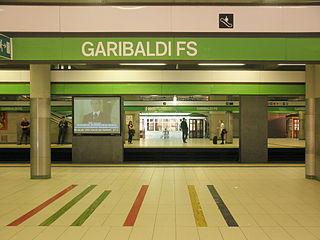
Line 2, is a subway line serving Milan, Italy, operated by ATM as part of the Milan Metro. It is also called the Green Line,, as it is visually identified by green signs.

Line 5 is an underground rapid transit line in Milan, Italy, part of the Milan Metro. The line, also known as M5 or the Lilac Line, is 12.8-kilometre (8.0 mi) long and goes through the city from the north to the north-west. It opened in stages between 2013 and 2015.

Montenapoleone is a station on Line 3 of the Milan Metro which opened on 1 May 1990, as part of the inaugural section of the line between Duomo and Centrale. Initially, Duomo was connected with Centrale by shuttle service, and on 16 December 1990, with the extension of the line to Porta Romana, full-scale service started.
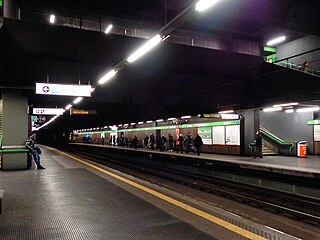
Sant'Ambrogio is an underground station on Line 2 of the Milan Metro. It was opened on 30 October 1983 as part of the extension of the line from Cadorna to Porta Genova. The station takes the name from nearby Basilica of Saint Ambrose.

Lanza is an underground station on Line 2 of the Milan Metro. The station was opened on 3 March 1978 as part of the extension from Garibaldi FS to Cadorna.

Garibaldi FS is a station on Lines 2 and 5 of the Milan Metro, and the Milan Passante railway. The Line 2 station was opened on 21 July 1971 as part of the extension from Centrale. It served as the western terminus until 3 March 1978, when the first trains could travel the new route to Cadorna. The Passante station was opened in 1997, and the Line 5 station in 2005.

Gioia is a station on Line 2 of the Milan Metro. The station was opened on 21 July 1971 as part of the extension from Centrale to Garibaldi FS.
Cimiano is a district (quartiere) of Milan, Italy. It is located within the Zone 3 administrative division, north-east of the city centre. The Milan Metro stops at Cimiano.
Milano Lambrate railway station is one of the main stations serving the city and comune of Milan, Italy.
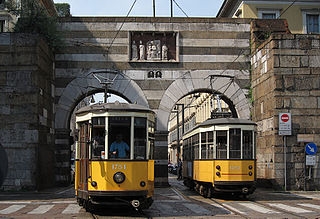
The Milan tramway network is part of the public transport network of Milan, Italy, operated by Azienda Trasporti Milanesi (ATM).
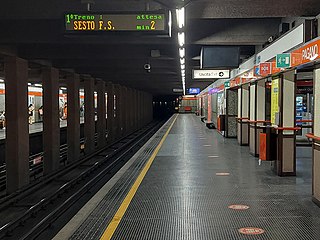
Pagano is a station on Line 1 of the Milan Metro in Milan, Italy. The underground station was opened on 1 November 1964 as part of the inaugural section of the Metro, between Sesto Marelli and Lotto. On 2 April 1966, a section from Pagano to Gambara was added. It is located on Via Mario Pagano. The line branches here; trains continue toward either Bisceglie or Rho Fiera.

The Milan S Lines constitute the commuter rail system serving the metropolitan area of Milan, Italy. The system comprises 12 lines serving 124 stations, for a total length of 403 km. There are 415 trains per day with a daily ridership of about 230,000.

Line 4 is an underground rapid transit line in Milan, Italy, part of the Milan Metro. The line color is blue. The first section opened on 26 November 2022 and as of 2023 it is 7.3 km long with 8 stations. The full line is expected to open by 2024. Once completed, the line will be 15 km (9.3 mi) long with 21 stations.

Porta Genova is a station on Line 2 of the Milan Metro. It was opened on 30 October 1983 as the terminus and part of the extension of the line from Cadorna. On 3 April 1985 the line was extended to Romolo.

Piola is a station of the Milan Metro, on line M2. The station grants direct access to the Politecnico di Milano (POLIMI).
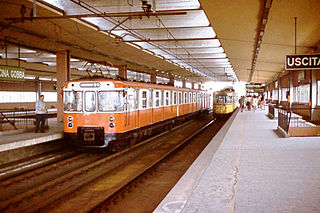
Cascina Gobba is a station on Line 2 of the Milan Metro. The station is located on Via Padova at the west side of the A51 Milan bypass road. This is beside the major highway interchange known as Cascina Gobba, which is the main vehicular transportation hub of northeast Milan, Italy. The line branches here to terminate at either Cologno Nord or Gessate.

The Zone 3 of Milan, since 2016 officially Municipality 3 of Milan, is one of the 9 administrative divisions of Milan, Italy.

















